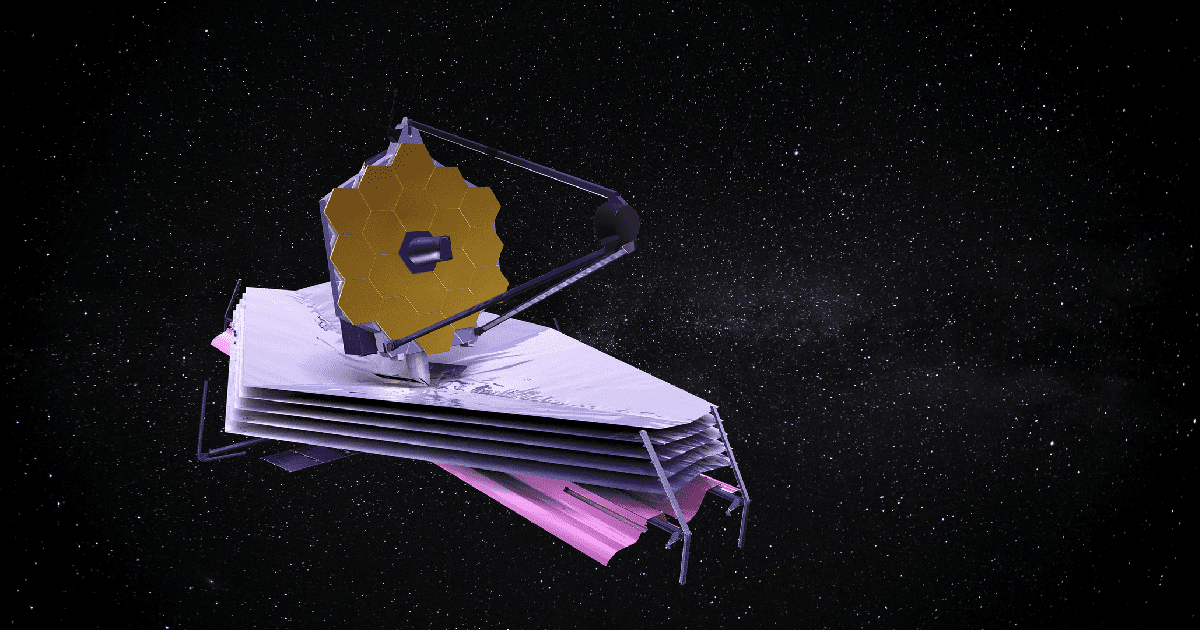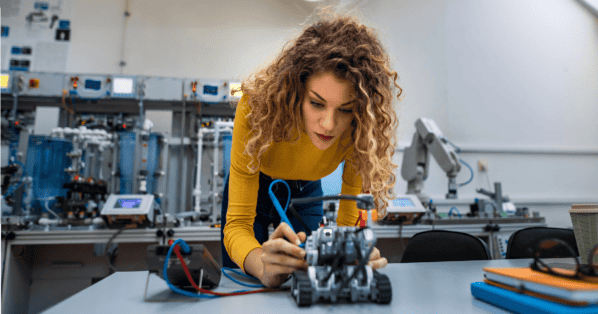James Webb Space Telescope (JWST) one of the most advanced engineering accomplishments of modern history. The project came about after decades of planning, years of engineering, and countless iterations of testing and refinement until its eventual launch on December 25, 2021, from French Guinea aboard an Ariane 5 rocket. The project was a true global collaboration between National Aeronautics and Space Administration (NASA), Canadian Space Agency (CSA), and the European Space Agency in addition to many other private and public sector partners.
In 2017, when there was a launch date in 2018 for the JWST, SWE started a conversation with Sandra Irish about her work on the JWST, and various technical obstacles she worked to overcome as the project took its final stages. We continued this conversation almost four years later after the launch of JWST and are pleased to share both portions of the interview here.
About Sandra Irish
Sandra Irish is the James Webb Space Telescope NASA Mechanical Systems Lead Structures Engineer and has worked on the project for the past 16 years. She is responsible for system level structural analyses and structural testing for JWST. In this role, she ensures that the entire observatory will not break or get damaged during its launch, departure from orbit, and travel to its final orbit. Now, after a successful launch on December 25, 2021, and full deployment of the JWST, she will work to ensure there are no disturbances of motion as the telescope will meet its performance metrics after cooldown to its operating temperature. As she said, “[JWST must be} stable to take a good picture!”
First Conversation – December 2017: Pre-Launch
SWE: As Lead Structural Engineer, can you tell us about your day-to-day work and long-term goals you want to achieve?
Irish: It varies depending on the phase of the program. During the design phase, there are lots of meetings and discussions and computer work making computations and perfecting the mechanical designs. During the integration phase, we verified the hardware being made is meeting the design, checked the hardware as it becomes available, and made changes to our computations to prepare for testing. During the test phase, we are in the test labs involved in the hardware testing, looking at data, determining if our design is performing as we expect. We work a lot in teams and there is much coordination with other engineers.
SWE: What are some of the primary challenges you address or have addressed in your work on the James Webb Space Telescope?
Irish: For my job as lead structures engineer, we have to design the telescope to survive launch at ambient temperature but then perform on-orbit had cryogenic temperature, ~-400F. Also, we have a tight stability requirement, so we must be very stable when we are obtaining data on-orbit, so we needed strong, thermal stable materials. In addition, we must be able to stow inside the fairing of a rocket and then open-up to our fully deployed configuration, so we have to survive these deploying and shock loads both in ambient and cryogenic temperatures. This is all new challenges for the JWST telescope design. In addition, there are so many people working on JWST around the US and in the world, that coordination with many people of different backgrounds has been a big challenge and is very important to clearly communicate.
SWE: Since the project’s inception in 1996, technology has rapidly expanded and grown – probably far past anything we could have projected over 20 years ago. How has the JWST evolved to incorporate latest technologies and perhaps even push the limits of what was thought possible?
Irish: JWST has the largest primary mirror to fly into space. It is also a segmented mirror which is a new concept. We are also using new materials that have been designed for its strength and temperature stability properties so we can weigh within the rocket lift capability, survive launch, and have limited movement once at cryogenic temperatures. Already NASA is working on the design of the next great telescope, which will have more mirror segments, larger mirror size and tighter optical performance for shaper pictures.
SWE: How has the JWST evolved to push the boundaries of space exploration?
Irish: JWST goes beyond Hubble Space Telescope in searching back in time to understand the first light of the universe and galaxies being formed. JWST is an infrared telescope which goes beyond the visible and see more phenomena with more precision than Hubble.
SWE: In thinking about what the JWST will accomplish, what is most inspiring to you?
Irish: Of its four primary science goals—first light, galaxy assembly, birthplaces of stars and planets/life—finding new planets and the possibility of finding water and new life is the most exciting to me!
Second Conversation –January 2022: Post-Launch
SWE: During the final year or two, what were some of the primary engineering challenges that you worked on to make the JWST successful?
Irish: My team and I successfully completed observatory level mechanical acoustics and vibration testing in the Summer to Fall of 2020. Then, my team and I were involved in transportation of the observatory from Northrop Grumman in Redondo Beach, CA to Kourou, French Guiana, South America. This involved critical lifts of the observatory, rotation of the observatory from launch configuration to horizontal configuration, monitoring the responses of the hardware during road and sea transport, and successfully unpackaging it at the launch site. Of course, the next big challenge was launch which was primarily performed by Arianespace, which was successful! As soon as the observatory was separated from the rocket, the JWST Mission Operations Team took over control of the observatory and now, a little over three weeks after launch, the observatory is fully deployed and working on adjustments of the mirrors.
SWE: Can you tell us about some of the logistical challenges to transferring the JWST to French Guiana?
Irish: some of the challenges were (1) to design the shipping container to handle mechanical loads from the road and from the ocean, keep the observatory clean and at uniform temperature and humidly, and to obtain sufficient clearance for installation and mechanical motion during transport, (2) to lift and rotate the observatory to fit inside the shipping container, and (3) to install sensors to continuously monitor the motion of the observatory during transport. It is similar to successfully packing your suitcase for travel so that your items don’t get damaged or move out of position until your suitcase gets to its final destination.
SWE: Where were you when you watched the launch of JWST and what emotions did you experience during the launch?
Irish: The plan for launch was to attend a viewing event with other JWST employees at NASA/Goddard Space Flight Center in Greenbelt, MD. But, due to COVID, all in-person viewing events were canceled. I watched the launch at home with a Teams meeting with my JWST colleagues so we could monitor the NASA live feed as well as the Mission Operation Center Quintron voice loops. I experienced many emotions starting with little sleep the night before, getting up early to begin the meeting with my colleagues, nervousness, and excitement! I did not celebrate until the solar array was deployed and the mission operation center declared that the observatory had power!
SWE: When the JWST launched, NASA reported there were 344 single point failures that could cause the telescope to fail. Now, the system is fully deployed, and the mission has a much higher chance of success than even a few weeks ago. Can you talk about some of the protective measures you were involved with to help protect against any one of the fail points?
Irish: The key to reduce risk of single point failures is excellent workmanship and sufficient ground testing! It was critical that our mechanisms be properly integrated, tested, and stowed before launch and all these operations were performed under close observation by mission assurance engineers and mechanical engineers! This was done so carefully on the ground, and it worked well, since all deployments were successful on-orbit!
After launch, JWST continues in its successful deployed and now is in the final stages of mirror alignment prior to an extended cooling period while it enters a unique orbit around the second Lagrangian Point. To follow real-time updates on the ongoing progress of the JWST, view this live tracker hosted by NASA. Once fully operational, the JWST will be available
SWE congratulates to all those involved in the inception, development, and ongoing support of this global endeavor!


Author
-

SWE Blog provides up-to-date information and news about the Society and how our members are making a difference every day. You’ll find stories about SWE members, engineering, technology, and other STEM-related topics.






